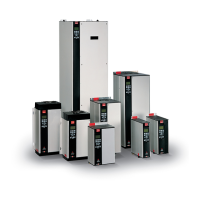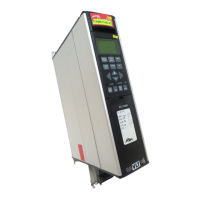2-11
VLT is a registered Danfoss trademark
Cooling Fans
All drives in this size range are equipped with cooling fans to
provide airflow along the heatsink. Units in NEMA 1 (IP21)
and NEMA 12 (IP54) enclosures have, in addition, a fan
mounted in the enclosure door to provide additional airflow to
the rest of the unit. Units in chassis (IP00) enclosures have, in
addition, a fan mounted to the top of the unit to provide
additional cooling.
Some drives in this size range have a small 24 VDC fan
mounted on the input plate. This fan is only mounted on E-frame
size units equipped with both an RFI filter and mains fuses.
The fan provides air flow around the main fuses. The fan
operates anytime the drive is powered.
All fans are powered by the main line voltage which is stepped
down by an autotransformer and then regulated to 200 or
230 VAC by circuitry provide on the power card. On/off and
high/low speed control of the fans is provided to reduce overall
acoustical noise and extend the life of the fans.
Regardless of the heatsink temperature, the fans are started
shortly after main input power is applied to the drive. If the
heatsink temperature is below 86°F (30°C), the fans will turn off
after a short interval. At a heatsink temperature of greater than
113°F (45°C), the fans are switched on at low speed. This
equates to approximately 200 VAC applied to the fans. At a
heatsink temperature of more than 122°F (50°C), 230 VAC is
applied to the fans to obtain full speed. When the heatsink
temperature returns to less than 104°F (40°C), the fans return
to low speed. Below 86°F (30°C)the fans switch off.
Since the internal ambient temperature is maintained by one
or more 230 VAC fans, the transition between low and high
speeds also occurs if the internal ambient rises, regardless of
heatsink temperature. The internal ambient temperature
sensor is located on the power card. If the internal temperature
rises to greater than 95°F (35°C), the fans will switch to high
speed, regardless of the heatsink temperature. If the internal
ambient temperature returns to 86°F (30°C) and the heatsink
temperature remains below 122°F (50°C), the fans will return
to low speed.
The fans switch to low speed should a heatsink over
temperature trip occur. In addition, regardless of any
temperature, when the load current on the drive reaches
60% of its continuous rating the fans are switched on at low
speed and then follow the temperatures as listed above.
Load Sharing
Units with the built-in load sharing option contain terminals 89
(+) DC and 88 (-) DC. Within the drive, these terminals connect
to the DC bus in front of the DC link reactor and bus
capacitors.
The use of the load sharing terminals can take on two different
configurations.
In one method, the terminals are used to tie the DC bus circuits
of multiple drives together. This allows for the possibility of one
drive that is in a regenerative mode to share its excess bus
voltage with another drive that is in the motoring mode. When
applied correctly, this can reduce the need for external dynamic
brake resistors while also saving energy. In theory, the number
of drives that can be connected in this way is infinite, however,
the drives must be of the same voltage rating. In addition,
depending on the size and number of drives, it may be necessary
to install DC reactors and DC fuses in the DC link connections
and AC reactors on the mains. Attempting such a configuration
requires specific considerations and should not be attempted
without first consulting Danfoss Application Engineering.
In the second method, the drive is powered exclusively from
a DC source. This is a bit more complicated. First, a DC
source is required. Second, a means to soft charge the DC
bus at power up is required. Last, a line voltage source is
required to power the fans within the drive. Again such a
configuration should not be attempted with out first consulting
Danfoss Application Engineering.
Specific Card Connections
Connector FK102, terminals 104, 105 and 106 located on the
power card, provide for the connection of an external
temperature switch. The input could be used to monitor the
temperature of an external brake resistor. Two input
configurations are possible. A normally closed switch may be
connected between terminals 104 and 106 or a normally open
switch between terminals 104 and 105. Should the input change
states, the drive would trip on an Alarm 29, Overtemperature.
The input SCRs would also be disabled to prevent further energy
from being supplied to the DC bus. If no such input is used, or
the normally open configuration is selected, a jumper must be
installed between terminals 104 and 106.
Connector FK103, terminals 100, 101, 102, and 103 located
on the power card, provide for the connection of line voltage
to allow powering the AC cooling fans from an external source.
This is required when the drive is used in a load sharing
application where no AC power is provided to the main input
terminals. To make use of this provision, the jumpers would
